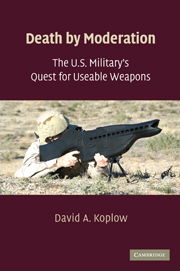Book contents
- Frontmatter
- Contents
- Preface
- Acknowledgments
- Abbreviations and Acronyms
- 1 Revolutionary Weapons and Transformed War
- 2 Deterrence and Self-Deterrence
- 3 The Law of Armed Conflict
- 4 Precision-Guided Munitions
- 5 Low-Yield Nuclear Weapons
- 6 Smart Antipersonnel Land Mines
- 7 Antisatellite Weapons
- 8 Nonlethal Weapons
- 9 What to Do about Useability
- Index
- References
8 - Nonlethal Weapons
Published online by Cambridge University Press: 05 June 2012
- Frontmatter
- Contents
- Preface
- Acknowledgments
- Abbreviations and Acronyms
- 1 Revolutionary Weapons and Transformed War
- 2 Deterrence and Self-Deterrence
- 3 The Law of Armed Conflict
- 4 Precision-Guided Munitions
- 5 Low-Yield Nuclear Weapons
- 6 Smart Antipersonnel Land Mines
- 7 Antisatellite Weapons
- 8 Nonlethal Weapons
- 9 What to Do about Useability
- Index
- References
Summary
Scenario 8
The beautiful but desperately poor and long-tumultuous nation of Ethalia is in chaos again. The previous government, whose grasp on control was always tenuous at best, collapsed in disarray months ago, ceding practical authority to half a dozen thuggish warlords; their ill-defined clan-based rivalry now erupts in daily bloodshed. The ubiquitous competing gangs – they are hardly organized or coherent enough to be characterized as forces engaged in a civil war – wreak perpetual havoc in the capital city and much of the surrounding countryside. The armaments of choice, mostly small arms and light weapons, have proliferated widely, and squads of irregular, nonuniformed fighters intermittently patrol the main streets, setting up roadblocks to search for rivals, to recruit or impress new members, and to extort money from civilians. The national economy has ground virtually to a halt and the civilian infrastructure is crumbling, resulting in widespread hunger, now approaching starvation levels. Outbreaks of infectious diseases, especially malaria, are also surging, as massive flows of refugees collect in ad hoc, poorly administered, and increasingly squalid encampments.
Pursuant to an emergency resolution by the United Nations Security Council, the United States has undertaken a limited intervention mission, with an expeditionary force of 2200 Marines dispatched to Ethalia in pursuit of three articulated goals: (a) to protect the skeleton staff of U.S. and U.N. diplomats who remain at their posts and the few hundred private citizen foreigners (mostly Americans, but several European and other nationals, too) who have chosen not to evacuate; (b) to safeguard the American embassy, which now serves as the Marines' own base, and to the extent possible, protect other nations' embassies and foreign-owned private corporate and nongovernmental organization properties, too;
Information
- Type
- Chapter
- Information
- Death by ModerationThe U.S. Military's Quest for Useable Weapons, pp. 188 - 215Publisher: Cambridge University PressPrint publication year: 2009
